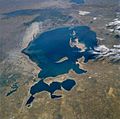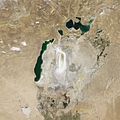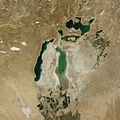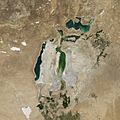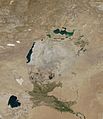Aral Sea facts for kids
Quick facts for kids Aral Sea |
|
|---|---|
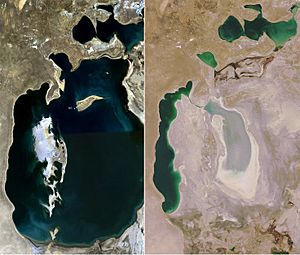
The Aral Sea in 1989 (left) and 2008 (right)
|
|
| Location | Kazakhstan - Uzbekistan, Central Asia |
| Coordinates | 45°N 60°E / 45°N 60°E |
| Type | endorheic, natural lake, reservoir (North) |
| Primary inflows | North: Syr Darya South: groundwater only (previously the Amu Darya) |
| Catchment area | 1,549,000 km2 (598,100 sq mi) |
| Basin countries | Afghanistan, Kazakhstan, Tajikistan, Turkmenistan, Uzbekistan |
| Surface area | 17,160 km2 (6,626 sq mi) (2004, four lakes) 28,687 km2 (11,076 sq mi) (1998, two lakes) 68,000 km2 (26,300 sq mi) (1960, one lake) North: 3,300 km2 (1,270 sq mi) (2008) South: 3,500 km2 (1,350 sq mi) (2005) |
| Average depth | North: 8.7 m (29 ft) (2007) South: 14–15 m (46–49 ft)(2005) |
| Max. depth | North: 42 m (138 ft) (2008) 18 m (59 ft) (2007) 30 m (98 ft) (2003) South: 37–40 m (121–131 ft) (2005) 102 m (335 ft) (1989) |
| Water volume | North: 27 km3 (6 cu mi) (2007) |
| Surface elevation | North: 42 m (138 ft) (2007) South: 29 m (95 ft) (2007) 53.4 m (175 ft) (1960) |
The Aral Sea (Kazakh: Арал Теңізі (Aral Tengizi), Uzbek: Orol dengizi, Russian: Аральскοе мοре) is a lake in Central Asia. It is between Kazakhstan in the north and Karakalpakstan, an autonomous region of Uzbekistan, in the south.
Since the 1960s, the Aral Sea shrank. 90% of the sea has gone. The rivers that fed it (the Amu Darya and the Syr Darya) were used by the Soviet Union for irrigating cotton production. What is left of the Aral Sea is heavily polluted, largely as the result of weapons testing, industrial projects, and fertilizer runoff before and after the breakup of the Soviet Union.
There is a project to save at least the northern part of the Aral Sea. For this, a dam was built in the 1990 to stop water running off. Climate improved in the following years, and water levels rose again. However, that dam broke, and was rebuilt in 2005, with international funding.
Another problem was that the Island of Rebirth had been used for the testing of biological weapons until 1993. It is currently contaminated with anthrax, the plague, and tularemia. Since 2001, it is no longer an island, but a peninsula.
Images for kids
-
The Ukrainian stickleback (Pungitius platygaster) was the only native species of the Aral Sea to survive its reduction and salinization.
-
The European flounder (Platichthys flesus) was a saltwater fish introduced to the Aral Sea.
-
Zebra mussel (Dreissena polymorpha), a former dominant member of the sea's benthic fauna, and has since returned to the North Aral Sea.
-
First Russian boats on the Aral Sea, watercolor by Taras Shevchenko, 1848
-
Cotton picking in Uzbekistan. Cotton is one of the biggest water consuming plants.
See also
 In Spanish: Mar de Aral para niños
In Spanish: Mar de Aral para niños

















